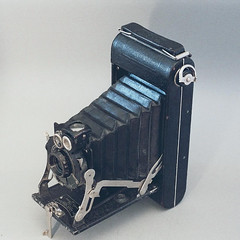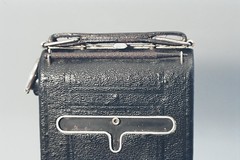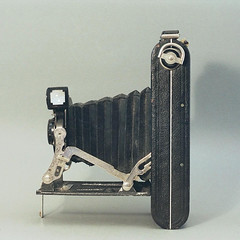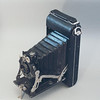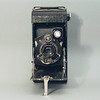Difference between revisions of "Pocket Kodak No. 1 series II"
m (space removed) |
Rebollo fr (talk | contribs) (switching from link to template for McKeown) |
||
| Line 2: | Line 2: | ||
[http://www.flickr.com/photos/50678983@N00/168465073/in/pool-camerapedia http://static.flickr.com/48/168465073_2118b92c21_m.jpg] | [http://www.flickr.com/photos/50678983@N00/168465073/in/pool-camerapedia http://static.flickr.com/48/168465073_2118b92c21_m.jpg] | ||
</div> | </div> | ||
| − | The pocket [[Kodak]] No. 1 series II is a [[folding]] A[[120 film]] camera made from 1922 to 1931(according to | + | The pocket [[Kodak]] No. 1 series II is a [[folding]] A[[120 film]] camera made from 1922 to 1931 (according to {{McKeown}}). It uses [[autographic]] rollfilm that was produced by Eastman Kodak between 1914 and 1934. All [[Pocket Kodak]] cameras had the autographic feature. The negative size is 6×9 cm or 2 1/4×3 1/4 inch. It has a Kodak anastigmat 108/7,7 lens. That's not a fast lens. The Diomatic No. 0 shutter has six settings, B, T 1/10 1/50 1/100 and 1/200s. That's not bad at all. It even has an exposure advice. Select aperture and lighting conditions ''dull, gray, clear'' or ''brillant''. At the shown aperture "figures indicate required exposure" as it states on the lever. Later models, like the [[Kodak autographic 2c]], even have a rangefinder coupled to the lens plate to help focusing the camera instead of guessing the distance. |
<br> | <br> | ||
---- | ---- | ||
Revision as of 18:28, 17 June 2006
The pocket Kodak No. 1 series II is a folding A120 film camera made from 1922 to 1931 (according to McKeown). It uses autographic rollfilm that was produced by Eastman Kodak between 1914 and 1934. All Pocket Kodak cameras had the autographic feature. The negative size is 6×9 cm or 2 1/4×3 1/4 inch. It has a Kodak anastigmat 108/7,7 lens. That's not a fast lens. The Diomatic No. 0 shutter has six settings, B, T 1/10 1/50 1/100 and 1/200s. That's not bad at all. It even has an exposure advice. Select aperture and lighting conditions dull, gray, clear or brillant. At the shown aperture "figures indicate required exposure" as it states on the lever. Later models, like the Kodak autographic 2c, even have a rangefinder coupled to the lens plate to help focusing the camera instead of guessing the distance.
The camera was disigned to use A120 film. To benefit from this autographic feature, a stylus with an Art Deco look was included (just above the window). Very often the stylus is lost on cameras you find at photographica fairs. On the back of the camera, you find the obvious red windows used for framecounting. On this camera, a little advice was imprinted in the black leather: use film No A120. Nowadays, all you can use is simple 120 film.
Viewfinder
The finder is a prism that, when looked at from a distance, gives you an idea of framing. The prism can be put in a horizontal or vertical position, so composing can be done by looking into it from above or from the side of the camera. The prism field is shows swiss cross for portrait or landscape pictures.
Transport
The film is wound by a lug on top of the camera. Just wind untill the next framenumber apperas in the red window in the back. Naturally, the shutter has to be cocked seperately, on the lens.
